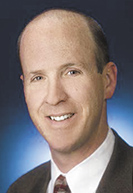Subscriber Benefit
As a subscriber you can listen to articles at work, in the car, or while you work out. Subscribe Now
Roughly 17-1/2 acres of city-owned downtown property in various stages of the redevelopment process have local and regional firms chomping at the bit to make their mark on the city’s skyline.
Already, city officials have put out requests for proposals for two properties—City Market and Jail II—with action expected on several more by the end of 2023. The list also includes the City-County Building, the downtown heliport, Jail I and Old City Hall.
The total acreage is believed to be the most land the city has made available for downtown projects since Unigov was established in 1970. And it doesn’t include Circle Centre Mall, which has a private owner that is considering redevelopment options, likely in concert with the city.
Developers say the redevelopment likely to result from the city-controlled properties could transform downtown’s Market East Cultural District, which is generally bounded by New York Street and railroad tracks from north to south, and Delaware Street and East Street from west to east. They predict an influx of housing, retail and flexible office space that could better connect downtown to the near-east side, just across the Interstate 65/70 barrier.
Most of the land would be considered in the core of downtown, but two sites—Jail II and the Arrestee Processing Center, which are being offered together—sit along the west side of the combined-interstates leg. On the east side of the highway is the beginning of Elevator Hill, the former Angie’s List campus that is being redeveloped with housing, office and other commercial spaces.
So far, at least eight Indianapolis firms and one from Ohio have expressed interest in the proposal seeking ideas for the east-plaza portion of City Market and the adaptive reuse of Jail II.
Indianapolis-based TWG Development LLC participated in tours of both properties, a prerequisite to offering proposals for the sites, and is fleshing out its bids ahead of deadlines on March 11 and April 1, respectively.

Tony Knoble, president of the firm, said that, while the city’s various properties are coming up for bid gradually, he can’t recall seeing so much city-owned land being positioned for new uses. Even so, he’s confident the market will be able to cope with the influx.
“It is a lot of land at once, but I think there are some pretty good opportunities,” he said. “I think downtown can handle it, and there needs to be some new product.”
Knoble said his firm is interested in developing multifamily housing—which city officials have said they want more of in downtown’s core—on any of the properties that become available. He added that including some affordable units, which the city requires for new multifamily projects, could serve the market well because most downtown housing is at or near market rate.
In addition to the market plaza and jail site, Knoble said, TWG also responded last fall to a request for information on the City-County Building. An RFI allows developers to share ideas without making full proposals.
City officials are entertaining three suggestions for converting at least part of the 60-year-old structure into affordable housing, but a full proposal process is on hold until leaders determine space needs. About half of the building’s users have moved or will move to the Community Justice Campus in the Twin Aire neighborhood, southeast of downtown. That evaluation likely won’t come until later this year or sometime in 2023.
TWG isn’t alone in jockeying for prime downtown real estate.
Flaherty & Collins Properties, an Indianapolis-based apartment developer that completed the 360 Market Square apartment project in 2018, also has interest in the two available sites and others down the road.
“This is more land right in the central business district than what you would typically see coming together, but we think it’s a great opportunity for the city to bring on some great new projects,” said Jim Crossin, the firm’s vice president of development.

Other Indianapolis firms—1820 Ventures, Buckingham Cos., Stenz Corp., Gershman Partners, Citimark and Third Street Ventures—have also expressed interest in the two projects out for bid. So, too, has Model Group, an adaptive-reuse-focused firm from Cincinnati.
Too much at once?
It’s likely to take years—maybe a decade or longer—for all the sites the city has lined up to be fully redeveloped.
In fact, city officials are still trying to nail down timelines for making the Jail I and heliport properties available.
Deputy Mayor Taylor Schaffer said a request for information on the jail might go out by the end of this year, but that will be contingent on when the Marion County Forensics Services Agency moves to the Community Justice Campus.

Likewise, the Indianapolis Airport Authority is still waiting on the Federal Aviation Administration to decommission the heliport property so it can move forward with a partnership with the city to find a new use for the property. Unlike the other properties, that site likely will come with a hefty price tag for either the city or would-be developer, because the airport requires the land be sold at fair market value.
But even with a drawn-out timeline for several properties, some real estate experts fear a glut, which could depress development.
Mike Wells, president of Carmel-based REI Real Estate Services, which focuses on hotel properties nationwide, said the amount of land that’s being eyed is unusual. It’s nearly three times the six acres that held Market Square Arena, land the city spent more than a decade marketing after demolishing the arena in 2001. The space finally became home to Cummins’ regional distribution headquarters in 2017 and 360 Market Square apartments in 2018.
And Wells said the current redevelopment could be further complicated by external factors that might hamper investor interest in new projects—factors like climbing interest rates and construction costs, continued shakeups in the retail and office sectors, and even the invasion of Ukraine.

The drop in the number of downtown workers could also be a blow to interest in major investments in certain segments, he said, including residential projects—particularly with rising rent prices, more people working from home and no clear path to attracting more amenities downtown residents desire, such as additional retail.
“It all means it’s just going to be a little bit more difficult to find developers who are willing to take some of those risks,” Wells said. City officials will “have to be really careful with the way they try to balance things out and make sure that whatever projects are proposed are by people who are going to be economically feasible in the long run.”
He said developers also run a risk of putting together proposals that are too similar to one another, or having a concept proposed by one developer for one site, and something in the same vein proposed for another.
“I think it’s going to be a real tough chore for the city to be able to pull this off—that is, at least until the office situation is more stabilized,” Wells said.
Mall moves matter
The redevelopment of Circle Centre Mall is also a big question mark, he said, since the ownership group is looking to partner with a single firm to reposition the property.
“The mall situation is critical, and I think its redevelopment, if it is done judiciously, could solve two of our outstanding issues: restaurants and … appropriate retail,” he said.
Crossin said the fact that Indianapolis has so many strong development companies will negate any challenges presented by the new acreage.
“Indianapolis has a lot of really good developers, so I don’t think there’s too much being brought out at one time,” he said. “I don’t know [that] we will necessarily submit proposals on all of [the properties]. But of course, if we see the opportunity—if all turn out to be opportunities that we think we’ve got a good idea for—we’ll go after them.”
And TWG’s Knoble said if firms know how to properly prioritize their bids and can navigate the usual project challenges, the large amount of land coming online shouldn’t be a problem.
“If you’re a developer, that is something that you’re always thinking about,” he said. “I think it’s exciting that we may have so many developers—so many people—working on projects … within the area.”
He acknowledged bandwidth might be more difficult for firms who have less access to capital—even if they have strong ideas for certain parcels—so they might opt to work with another firm through a joint venture.
In fact, Gershman Partners and Citimark have partnered on a bid for the City Market plaza. The firms already own and are repositioning the three structures on the northern portion of the block, including the Gold Building. Though representatives of the firms didn’t return calls requesting comment, it’s expected the bid will propose incorporating the plaza with the firms’ ongoing effort.
Different strategy?
City officials have spoken frequently about the opportunities they see with the repositioning of their real estate holdings and the benefits of turning over several downtown parcels for redevelopment.
They’ve said they expect to offer incentives for most projects, including the use of tax-increment financing or other tools tied to affordable housing, if that’s a component of the projects. But city resources aren’t unlimited.
“We’ll be evaluating them as they come in,” Schaffer said. “All those considerations are on the table, but all of this has to be approached with a certain level of fiscal responsibility, understanding the … other needs that we have. We can’t over-incentivize one project to a degree that we’re not able to, in the future, do other projects.”
But from a planning standpoint, the city has changed its marketing strategy for these properties, using a decidedly developer-friendly approach rather than leaning on extensive studies or previous proposals to woo ideas.
In fact, the city hasn’t updated its study of the Market East Cultural District since its release in 2015—which didn’t take the city-owned parcels into account—and it hasn’t conducted comprehensive forecasts for the sites like it did recently for Irvington Plaza and Castleton corridor.
That’s because the Department of Metropolitan Development has instead focused on updating its comprehensive development plan for the county and is using that to inform its efforts. It will also soon start modernizing its plan for the city’s regional center—whose boundaries are defined as 16th Street on the north, I-65/70 on the east, I-70 on the south, and Belt Railroad tracks on the west—with hopes of hiring a consultant this spring.
Those two documents, coupled with the building studies, will provide high-level guide rails for private developers, with a focus on the city’s priorities and what it’s most interested in permitting for certain sites.
“I don’t know that at this time that we see a lot of value in doing area-specific plans for parts of downtown, just considering the regional center plan [is being updated] as a whole,” said DMD Director Scarlett Andrews.
She said the comprehensive strategy is “more holistic” and differs from the neighborhood-focused approach of the past. She added that the city already has strong confidence in market demands for more downtown housing, so it opted to move ahead with some RFPs instead of waiting until after the regional plan was completed.
“The neighborhood-based plans didn’t work, so we’ve taken a different approach to planning in the last … five or six years,” she said. “We know that there is a lot of demand for developing housing, in particular, but also developing on these key sites [in general]. I don’t think we saw a lot of value pushing that off longer.”
Crossin, of Flaherty & Collins, said he supports the city’s approach.
“We’re the ones who, at the end of the day, are going to make the projects happen,” he said. “I think the development community can bring good ideas that can actually come to happen, instead of [relying only on] the city saying what they want.”•
Please enable JavaScript to view this content.


It’s a lot to unpack here but overall think every one of those sites could and should be redeveloped. It’s going to positively affect this area of Indianapolis. Traffic will could be worse (it only gets worse in America) but at least the 65/70 split and I-69 will be completed before any of these projects break ground.
Let’s get it;!!!! Build up and involve rooftop Everything!!
Wells is always a wet blanket. “Don’t build the big hotel at Pan Am Plaza but let me build MY hotel in the Warehouse District.”
Wells is being realistic. Real estate development right now is highly sensitive to macroeconomic factors, especially the inflation and interest rate environments, which govern expected returns.
Wells is a clown! Build it and fill it!!! Don’t wait looking around while losing!!!!!! supposed to be top ten in Everything!!!!!!!!! Get busy!!!!!! Or get out the way!!!!!!!
Blah blah blah. This has been Indy’s problem since I moved here 30 years ago. Sooooo conservative. Don’t take risks. This is how cities like Austin and Columbus and Nashville have easily passed us up. Had we been more aggressive and progressive, we’d be more like Minneapolis at this point. Instead, we are a larger Louisville or Des Moines or Omaha. Grow a pair already, Indy.
Michael G–in the last two years, hundreds of businesses have fled downtown Minneapolis because the progressive city can’t seem to go four months without a riot.
The city represents the headquarters for Target…yet the DT Minneapolis Target closed. Now people are fleeing formerly stable neighborhoods because of the rash of home and car break-ins. The only place where housing starts are surging is in the suburbs.
I understand that there were a lot of smart development decisions made in that very politically homogeneous city, back in the good old days of 2017 and before. The same can be said for Seattle, which has also turned into a cesspool. In what reasonable way should any of the other cities listed be emulating MPLS?
Always risky to share your ideas and development concepts with politicians. They can’t be trusted and oftentimes bring in one of their big political contributors, party buddies and friends. Good way to get blindsided. I know, because it has happened to me.
Explain and expose the buster!!
It’s still better than those cities you named but it’s got to move on away from entertaining others!! Time for the city to show the world what it really is!!! Vote all lames out!!!! And become top 20 Everything!!!!!!! Nothing can stop indianapolis!!! If they assert themselves correctly!!!! Plenty room for growth!!!! Miles of growth room!!!!
How many rfps have been sent out for the Old City Hall? Seems we go through this every two to three years and nothing ever happens with it.
Much potential here.
But..You must ABSOLUTLEY give me a REASON why I should live and or work downtown. I don’t think anyone can answer that right now. Young people living in downtowns eventually meet, marry, and buy homes in the burbs. What schools do I send my kids to downtown? Do I have to drive to shop and run errands on the weekends? Is the bank open? How far away is Costco? These are real concerns in many cities.
The restaurant scene is more varied and vibrant than anywhere else in Indiana (Mass Ave, fountain square, downtown proper, irvington though thats a little bit of a drive). The walkability (and bike) is, again, better than anywhere else in Indiana due to the cultural trail and interconnectedness of mass ave, downtown, fountain square and the surrounding areas. As far as entertainment and shows, I would argue downtown is best though there is some stiff competition around the state. With the shows on Mass Ave and downtown, the sporting events, and the festivals using the parks, downtown has an argument to make that they are the best in entertainment.
Granted there are downsides. The school options arent great. Traffic can be bad as can parking. For errands, yeah there is no big box store (Walmart, target, etc) which is frustrating and the grocery stores are smaller than average due to space.
But there are PLENTY of reasons to live downtown, though much less so if you have kids.
I’ve looked at moving to the burbs a couple of times but have decided to stay downtown for one big reason – it’s a lifestyle decision. If you enjoy walking to get a cup coffee, regularly meeting friends out for dinner, using the monon/canal for running and biking, and a number of other things, then downtown is right for you. Yes, the suburbs have all those things but I can do those without ever getting into my car from my home downtown. Not to mention, I appreciate the diversity and living among more likeminded people. But, if kids and schools are your primary focus then suburbs with homes that have more square footage and larger yards might be better. I still make a trip to costco or the mall every couple of weeks but it’s no more inconvenient to do that from downtown than it would be the burbs. I know traffic downtown sucks but have you seen traffic in Fishers?
Downtown is also for people who don’t like wasting their lives commuting. Driving 20-30 minutes from the burbs — twice every day — is a complete waste of time. I can get to work by car, foot, bike or bus in 5-10 minutes depending on my mood and mode of travel.
And yes, we have great schools downtown. And yes, the banks have regular hours. And yes, Costco delivers so who cares where it is. These are not real concerns.
The Minneapolis references is not accurate and reflects more of an opinion rather than a fact. Take a closer look at downtown Minneapolis housing, including new condo construction, and compare that to the much smaller Indianapolis market. Minneapolis anchors a major metropolitan area far larger than Indianapolis, includes strong and vibrant central city neighborhoods which are not being abandoned and still are vibrant, a refreshing change to far too much of Indianapolis’ burnt out, run-down unappealing central city. Minneapolis has focused more successfully that Indy on maintaining solid strong central city neighborhoods with moderate to high incomes. Perhaps this is due to the solid infrastructure (streets and sidewalks — one repeats, sidewalks), paved alleys, park system, trails, regional transit (not just Minneapolis), a major international airport (hub) and a historically broad base of employment. Minneapolis and Hennepin County, one of nation’s most populous, includes HQ of several Fortune 500 companies, a Federal Reserve Bank, Wells Fargo . . . .etc. Indianapolis is not in the league of Minneapolis. Despite the protests and unfortunate destruction along Lake Street in Minneapolis (which is not downtown); construction continues in both areas and both areas are much more lively and truly urban compared to Indianapolis.
And, Minneapolis has consistently had a much stronger and larger employment base downtown compared to Indy. Again, a metro area historically much larger, more progressive, better funding, better planned, better managed, and higher average income. Yet, both cities — as most in the US — can sadly identify bad apples among those sworn to serve and protect. Defunding is not the answer — however, accountability, transparency, training, adherence to rules, union protection, personal responsibility, and ending the code of silence and retaliatory actions must end.
Cease with the hyperbole . . . there is not a riot on a daily basis in Minneapolis. Don’t confound a Target store closing with a corporate presence.
As for crime and destruction, are there not homicides in Indianapolis, on a more than an infrequent basis? Furthermore the rise in crime during the pandemic has occurred nationwide and is not a particular peculiarity for both Minneapolis and Indianapolis.
Indianapolis dwarf’s!!!!! Minneapolis and st Paul combined!!! Google!!!!
Minneapolis metro population is: 3.690,261
Indianapolis metro population is: 1.858,000
in all fairness, Minneapolis adds the city of St Paul to its metro but when we look at Minneapolis city limits, its population is just 420,324, while Indianapolis has a population of 892,656. Yes Minneapolis metro is bigger but Indy city population is much larger. Indys suburbs like Fishers, Carmel, Nobelsville, Westfield, Greenwood eat, are all growing. Will Indys metro catch Minneapolis, maybe not in my life time but it depends on which stat you’re looking at to gauge which city is bigger. Indy has a few large companies both Fortune 500 and 5000 Hq here. Both cities are in cold midwest states and you either love the places or you hate them.